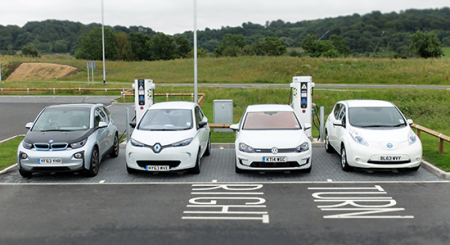I have previously covered the ins-and-outs of charging your electric car at home using a charge point or a 13 Amp cable:
- Charging an Electric Car: How it is Nothing Like Refuelling a Petrol or Diesel Car
- Installing a Charge Point for your Electric Car
If you want to charge your car away from home, and can’t get by with a 13 Amp ‘granny cable’, then you will need to join one or more of the national charging networks. That gives you access to the public charging points available around town centres and on the motorway and trunk road systems.
There are a number of sites where you can look up charging points, including:
In an occasional series I will cover the biggest networks: Electric Highway, Polar Network, POD Point and so on. Here we begin with the Electric Highway, created by Ecotricity and now owned and operated by Gridserve.
Electric Highway (Updated for 2022)
Website: Gridserve Electric Highway
Operated by: Gridserve
Online Map: Charge Point Map
Operator’s Description
“Our low-cost, rapid and high power charging infrastructure is reaching every corner of the UK, covering 85% of the UK’s motorway network.
We provide rapid and high powered charging at some of the lowest rates in the UK. Our next generation chargers are supported by renewable energy from our solar farms.”
Our View
If you join just one network it probably has to be the Electric Highway (EH) as they have a virtual monopoly on charging at motorway service areas (the exception being Tesla with their Superchargers). The good news is that the majority of services now have at least one rapid charger, an increasing number have two and some have even more. So for long distance driving with your electric car you can pretty much get around most of England by charging at motorway services. Coverage outside England (in Scotland and Northern Ireland, and particularly in Wales) is however poor.
The reliability of Ecotricity charge points has historically been quite poor, but this has started to improve since the takeover by Gridserve.
Curiously, apart from at motorway services the majority of EH rapid chargers are in the car parks of IKEA superstores (due to a partnership deal between them – see IKEA Electric Vehicle Charging).
The majority of EH rapid chargers were large white units manufactured by DBT-CEV. These provide DC charging at 50kW for CCS (BMW i3 etc.) and Chademo (e.g. Nissan Leaf and Mitsubishi Outlander) connectors, and AC charging at 43kW (Renault ZOE). Typically the first ones installed were ‘single headed’ with just Chademo cables for the Leaf. Later they were ‘double headed’ with the addition of a Type 2 cable for the ZOE. Current installs are ‘triple headed’ with the addition of a CCS cable for the i3 and Hyundai IONIQ.
Note that most EVs with a Type 2 connector (not the Leaf or Outlander) can be charged with any rapid through the Type 2 cable but only the ZOE can use it at full power (43kW or 22kW). Some can use it at reduced power (e.g. the i3 can use 11kW) but most will drop down to 7kW, like charging at home. You should use the CCS or Chademo connector for rapid charging, and only use the Type 2 if these aren’t working (it will be much slower).
Before using DBT rapids Ecotricity installed a small number of ‘medium’ chargers providing 22kW. Some of these are still in place and can be seen alongside the DBT ones; again, you should make sure that you understand which charger and cable/connector is most appropriate for your circumstances.




Pingback: Electric Car Charging Networks 2: Chargemaster's Polar Network - Fuel Included: Electric cars with FREE fuel
maurice smith